Community Composting
On this page:
Community Composting Basics
Community composting is a model of composting that sources organic materials locally, engages the community in the composting process, and uses the compost produced in local soils.
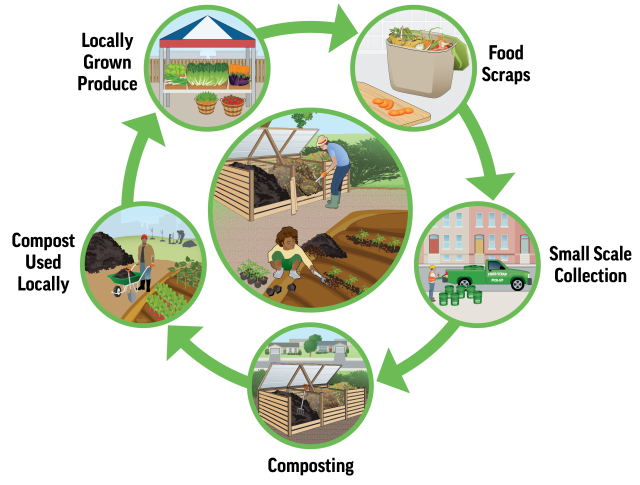
Community composting sites are local and often dispersed throughout a town, city, or neighborhood. They may be located at schools, farms, community gardens, parks and other public lands, at community organizations, and in rural to urban areas. Community composting can be scaled and designed to fit the needs and resources of a community. Though sites may be small compared to municipal or commercial composting facilities, community composting can scale up to handle more materials by adding sites to a network or expanding the size of existing sites.
Community composting is an important tool for organics recycling and landfill diversion, filling gaps in access and infrastructure while tackling climate change and providing a host of unique environmental, economic, and social benefits.
Community composters use a variety of composting methods, including three-bin systems, windrows, aerated static piles, and vermicomposting. They also represent different organizational and business models, including nonprofits, small businesses, farms, schools, community gardens, and worker-owned cooperatives. Community composting is often cheaper and less resource-intensive to set up than larger composting operations, as it requires less land and fewer materials (pdf)(27.1 MB). As with all scales of composting, it is important to use best management practices in community composting to produce high-quality compost and minimize odors and pests.
Learn about different methods for composting.
Benefits of Community Composting
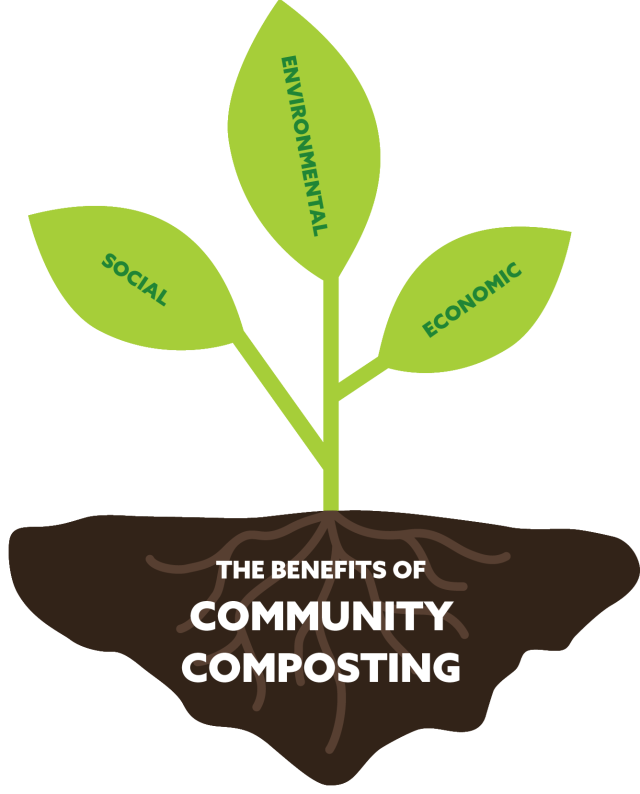
Like other models of composting, community composting offers benefits such as diverting organic materials, like food scraps, from landfills, reducing greenhouse gas emissions, and producing a valuable soil amendment - compost. Community composting offers additional unique benefits as it is a flexible model able to adapt to a community’s needs and resources, such as space available for composting, volume of organic materials collected, and local goals of sustainability or food sovereignty. Because the sourcing of materials, composting process, and use of the compost all happens within the same community, the benefits of community composting stay local. Community composting can be implemented anywhere with access to land, resources, people power, and supportive rules and policies.
Local Environmental Benefits
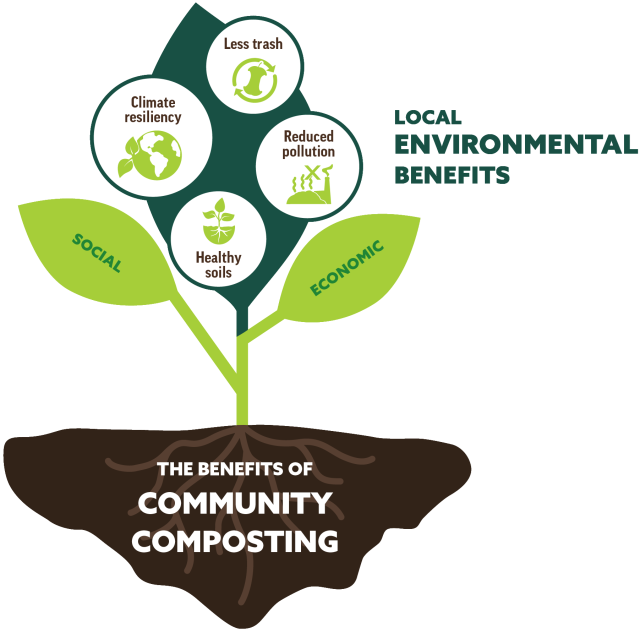
Community composting builds local soil health. Food scraps and yard trimmings are best kept within communities where they can be composted and returned to local soils in gardens, parks, yards, or farms. Collecting materials and using compost locally reduces greenhouse gas emissions produced from hauling materials and distributing compost long distances. Additionally, keeping organic materials out of landfills reduces emissions of methane, a powerful greenhouse gas.
Compost enhances soil quality by adding organic matter, providing slow-release plant nutrients, increasing water infiltration and retention, reducing soil erosion, and helping remediate contaminated soils. Compost can be used to help revegetate disturbed land and to manage stormwater runoff. Compost use also sequesters carbon in the soil – one of the many ways that composting combats climate change. Learn more about the environmental benefits of using compost.
Local Social Benefits
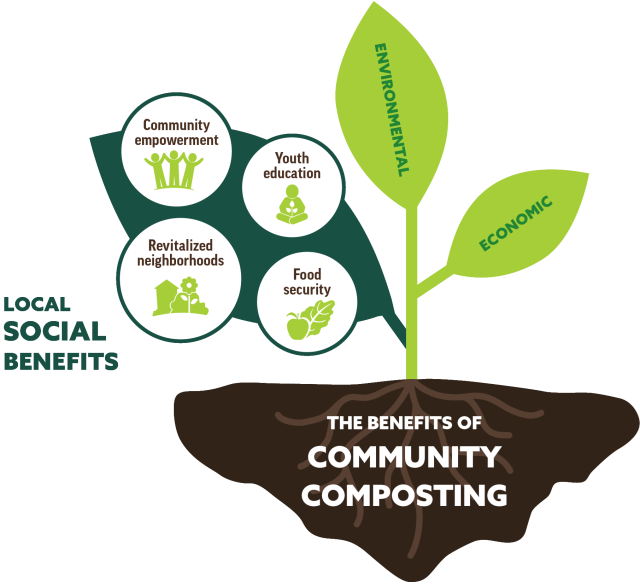
Community composting engages and empowers the community. Community composting programs are scaled to meet the needs of the community and can fill composting service access gaps. They also serve as green spaces and educational sites where people can learn how to compost, grow nutrient-rich food, reconnect to the food system, and spend time outside. Many community composters engage young people and provide job training. Community composting programs provide opportunities to volunteer, gather as a community, and work together on a common cause.
By participating in and supporting community composting, communities can gain a new perspective in which organic materials are a valuable resource rather than a waste product and can use that resource to build local soil health and grow local food. Local food helps address food insecurity and gaps in food access, especially by providing nutrient-rich fresh produce. Community composting brings skills, knowledge, and access to compost to communities, building resiliency in the community and in local food and waste management systems.
Local Economic Benefits
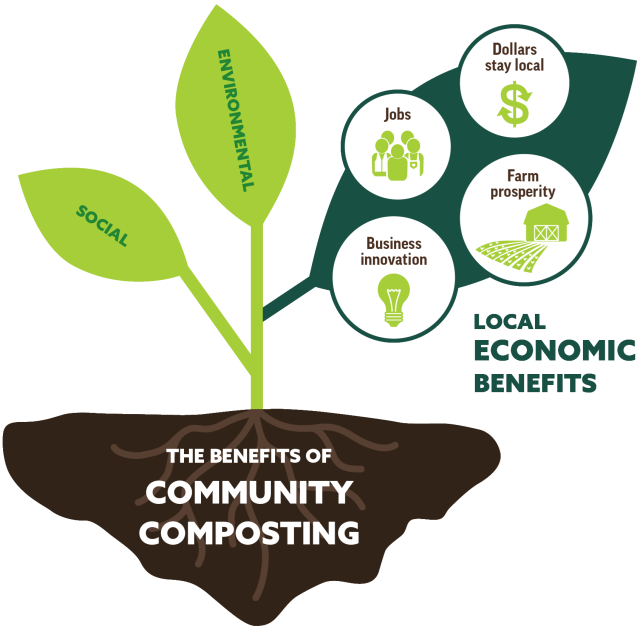
Community composting creates economic opportunities. Community composting empowers individuals, businesses, and institutions to collect organic materials formerly considered “waste” and repurpose them as a community resource. The composting industry sustains more jobs on a per-ton basis than landfilling or incineration (pdf)(17.3 MB). Many community composters and haulers are small business entrepreneurs, providing green jobs in their local communities.
When compost is produced and used locally, the dollars and resources that go into the process stay local, benefitting the community that provided the organic materials to be composted. Local compost is used to grow local food, supporting other small businesses and a resilient food system. Community composting sites provide space for education and job training, building skills and capacity to grow the green economy.
Additional Resources
More resources are available on other EPA composting webpages:
- Composting at Home.
- Approaches to Composting.
- Start a Composting Program.
- Composting Homepage.
- Benefits of Using Compost.
Visit the webpages below for more composting information:
- Composting for Community (Institute for Local Self-Reliance) – This site provides many useful resources on community composting including training, guides, best management practices, workshops, podcasts, webinars, the Community Composter Coalition, and an online certificate course.
- Community Compost Law and Policy Resource Hub (Sustainable Economies Law Center and Institute for Local Self-Reliance).
- Community-Scale Composting Systems – a book by James McSweeney.
- Community Composting Training (Composting Association of Vermont, Northeast Recycling Council, and Vermont Community Garden Network).
- Community-Scale Composting (CalRecycle).
- Lessons In Community Composting: A Series (BioCycle).
- Recursos para Compostaje en Español (Institute for Local Self-Reliance).
- Philadelphia Community Compost Manual (pdf) (45.7 MB) (Farm Philly).
